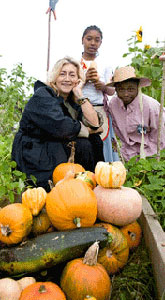-
 International year of Soil - Artist Residency
International year of Soil - Artist Residency
Karen has been working as artist in residence at Hannah's for International Year of the Soil. read more...Karen Francesca has recently been working as artist in residence at Hannah's at Seale Hayne for Ccanw for the International Year of Soil. There is a touring show that goes to Eden and Kew amongst other places.
The piece is called "Bread and Roses" It is made with groups of people accessing educational and therapeutic services at Hannah's. It is made of hazel, with a sweet chestnut shingle and hand made ceramic tile roof, a Cobb seat and 3 mosaic panels made at Bovey Tracey Contemporary Craft festival and Respect Festival Exeter.
Links with more information:
Soil Culture: Forum, Centre for Contemporary Art and the Natural World
Soil Culture at Create
Discover Hannah's
Click here for images of our Bread and Roses finished piece
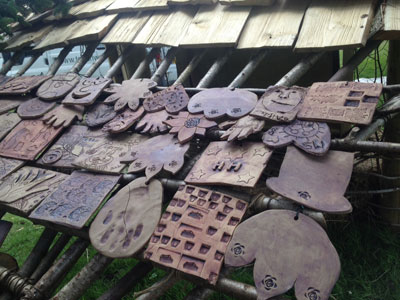
Prev
Next
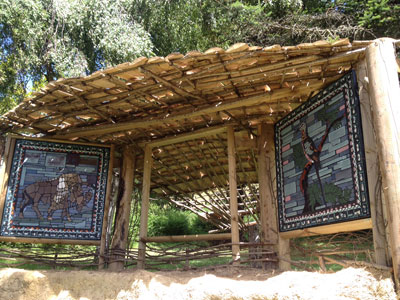
Prev
Next
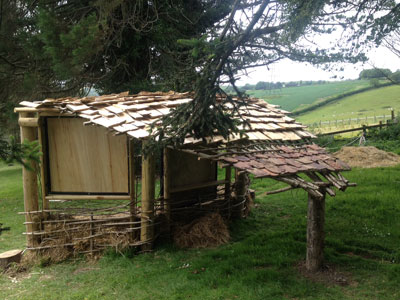
First
Prev
End of slideshow
-
 Human Nature Bristol
Human Nature Bristol
Karen Francesca has also been chosen as one of the artists at the Human Nature event. read more...
Karen Francesca has also been chosen as one of the artists showing
at the Human Nature event in Bristol.
Human Nature Bristol
Centrespace, Leonard Lane, Bristol, BS1 1EA
Friday 17th - Thursday 30th July, 11am-6pm
Private View Thursday 16th July from 6pm-9.30pm
Artists showing in Bristol include ATM, Ben Wilson, Justyna Budzyn, Louis Masai, Karen Francesca, Felicia Charles, Helen Jones, Pete Marsh, Tim Godwin, Ollie Gillard, Jonesy, Nicola Nemec, Lesley Hilling, Jane Laurie, John Brooks, Michelle Harvey, Marion Cheung and Walden. -
 Learning for a Sustainable Life
Learning for a Sustainable Life
Roundhouse construction process and woodland ecological report
read more...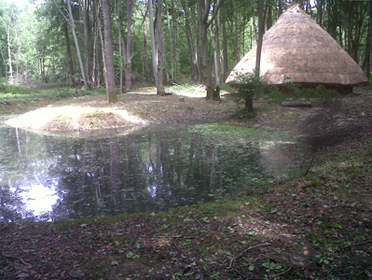
The roundhouse and pond are now establishing as habitat.
We now have an ecological report for our woodlands, click for a pdf of the report..Click here for wildlife report, creation progress photos and press articles.
Bird Life in Frith Wood
Four years ago the central part of the wood was thinned, leaving the oak standards. The aspen coppice here is now 3m tall and attractive to willow warbler and chiffchaff. The dense young birch plantation edging this more open area to the east is well populated with blackcap. The dead hedges made of brash which define this area provide protection for wrens, robins, small mammals such as weasels, as well as snakes. There are both grass snakes and adders in the wood.
The idea was that this area would be ideal spotted flycatcher habitat, and open-fronted nest boxes were installed, but so far none have been seen, no doubt due to the dramatic decline of this species. Buzzard now hunt in this area.
On the old ride which was opened up and restored to create a layered profile, there are chiffchaff, willow warbler, bullfinch and green woodpecker. The cleared copse opposite the roundhouse has also promoted the growth of wild flowers, including primrose and violet. This area and the sunlit ride with its bramble is a haven for fritillaries, white admiral and other butterflies and insects.Prev
Next
Bird Life in Frith Wood - continued
Mandarin duck have nested and successfully reared chicks in the tawny owl box on the ride. There are smooth newt already in the recently dug middle pond on the ride, as well as diving beetle, frogs and toads. Bats love hunting over the large pond by the roundhouse, and it seems they roost under the eaves of the roundhouse.
Sparrowhawk and great spotted woodpecker nest in the wood to the north of the ride. There are several species of tit living in the wood: great, blue, willow and marsh; standing deadwood has been left or created to provide nesting places and food sources for these as well as woodpeckers. Long tailed tit, nuthatch and treecreeper also benefit from the greater diversity of feeding habitats.
Click here for a list of bird species that have been found so far in Frith WoodPrev
Next
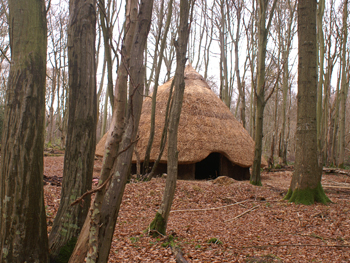
Our completed roundhouse. Read on to see more information and pics of the creation process.
Prev
Next
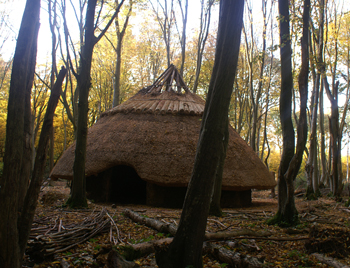
Over the last year volunteers, woodland experts, walkers, children, city dwellers, locals, ghost hunters, archeologists, students and europeans have gathered in Frith Wood and helped to make this environmental education centre.
Prev
Next
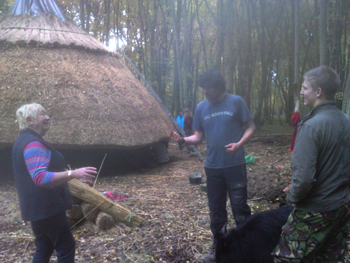
Woodland materials have been harvested and worked to create this wonderful, low impact building where people will come to learn more about the potential of using English woodlands in a sustainable way.
Prev
Next
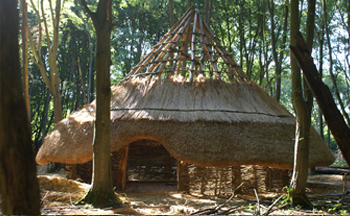
We have considered our heritage and traditional methods of building still used by the majority of people worldwide such as cob building, wattle and daub and thatching.
Prev
Next
In the process of building our Roundhouse, a new wildlife pond has been created, a 1 acre area of hazel has been coppiced, reed has been used that would have been burned and hundreds of people have met, talked, worked outside and got their hands dirty!
Click on pic to enlarge.
Prev
Next
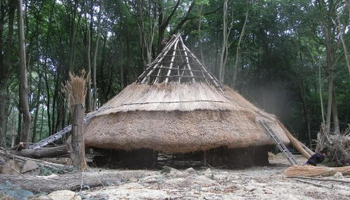
List of ingredients to create the roundhouse:
14 oak stakes for the henge, 3m in length,
14 oak beams for the ring beam 2.5m in length,
10 tons of clay and manure, 1250 bundles of water reed,
2400 hazel rods, 14 ash poles 8m in length,
40 hazel poles, 1500m of tarred marlin.Prev
Next
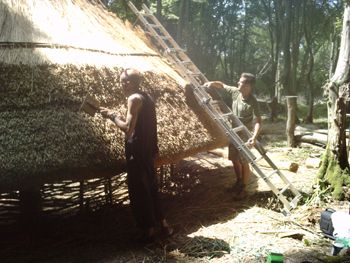
Thatching the roundhouse roof.
Prev
Next
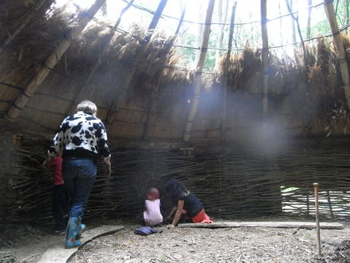
Volunteers applying daub to the inside of the roundhouse wall.
Prev
Next

Applying daub to the inside of the wattle walls.
Prev
Next
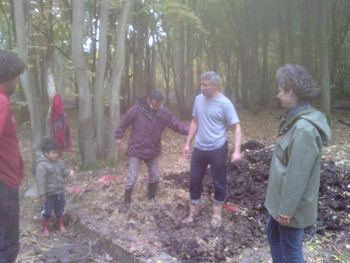
Making daub. 10 tons of clay and manure duab were applied to the walls which are now 70cm thick to aid insulation.
Prev
Next
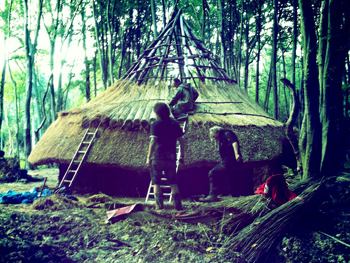
Volunteers thatching the roof and daubing the walls.
Prev
Next
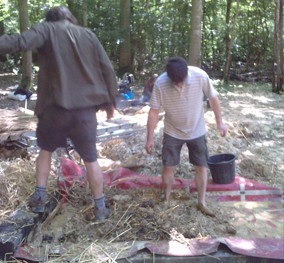
Making the daub for the wattle walls from clay, soil, straw and manure.
Prev
Next
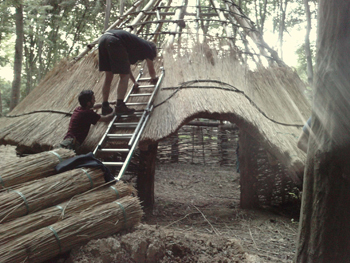
Teaching volunteers to thatch.
Prev
Next
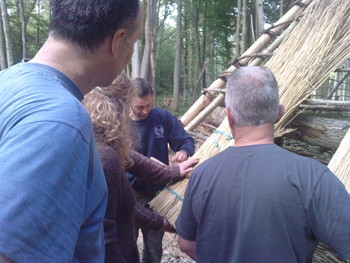
Volunteers learning to thatch.
Prev
Next
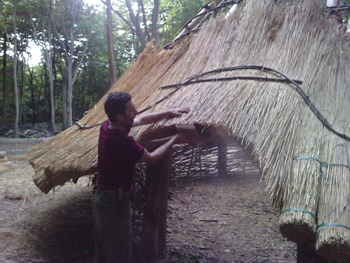
Thatcher and experienced roundhouse maker, Dafydd Wiliam.
See his website at www.theroundhouse.orgPrev
Next
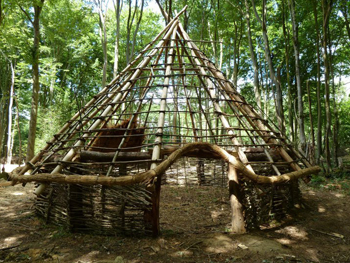
Roundhouse frame ready for thatching.
Prev
Next
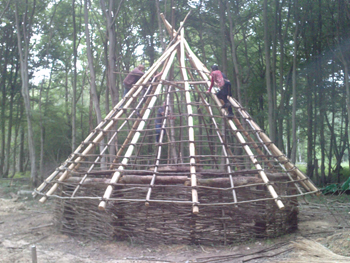
Tying the hazel rafters onto the main frame.
Prev
Next
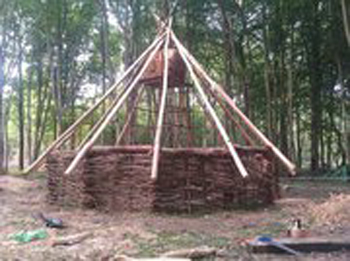
The ash roof poles in place.
Prev
Next
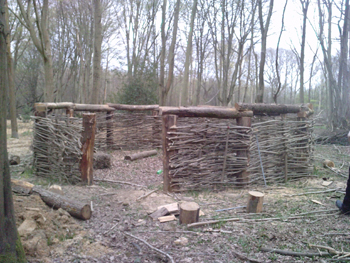
The hazel wattled walls are added.
Prev
Next
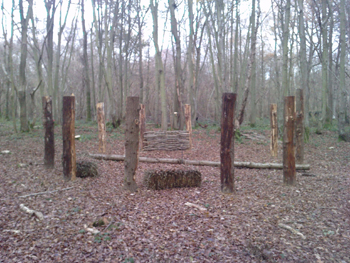
Roundhouse wood henge! The Oak beams are put in place first.
Prev
Next
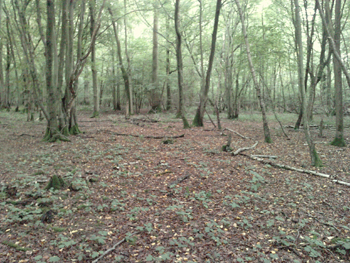
The woodland clearing we chose as the site for the Roundhouse.
Prev
Next
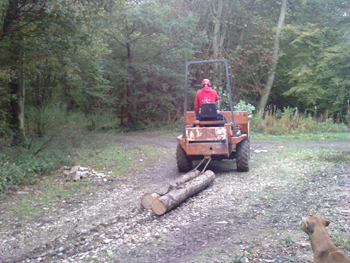
Removing oak beams from the woodland, ready to use for the roundhouse structure.
Prev
Next
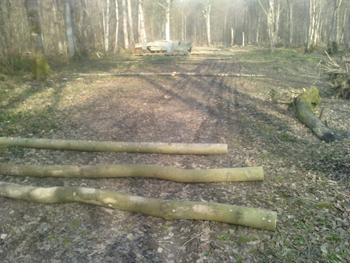
Ash poles to use for the roof of the roundhouse.
Prev
Next
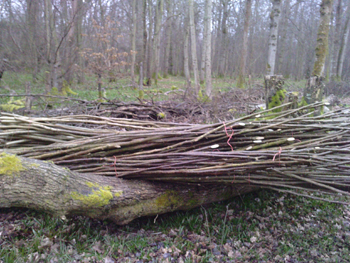
Coppiced hazel in the woodland.
Prev
Next
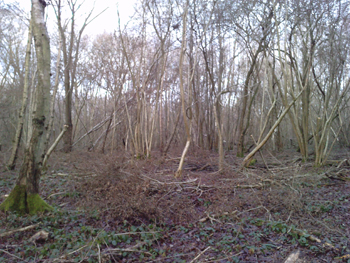
Woodland to be coppiced for the wattling.
Prev
Next
Press - click on pic for larger image
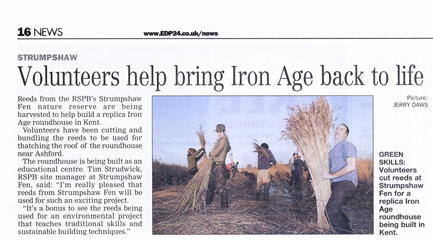
Prev
Next
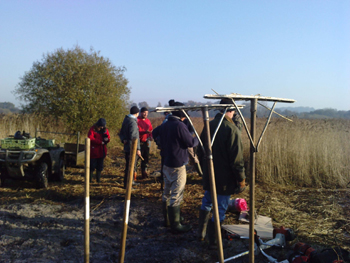
Volunteers at RSPB Strumpshaw fen.
Prev
Next
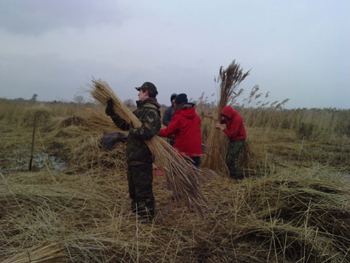
Volunteers reed collecting at Strumpshaw fen.
Prev
Next
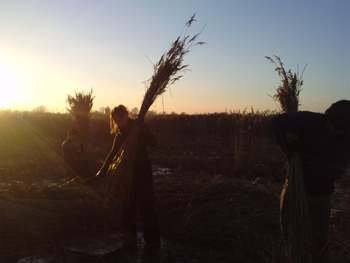
Volunteers reed collecting late on a winter day at the fen.
Prev
Next
Tim Strudwick, RSPB site manager at Strumpshaw Fen, says "I'm really pleased that reeds from Strumpshaw Fen will be used for such an exciting project. Reeds have traditionally been harvested in the Broads for thatching roofs so it's great to see this tradition brought back to life.
"Although reed cutting for thatch has declined nationally, at Strumpshaw Fen we still cut the reeds to benefit species like bitterns and bearded tits. It's a real bonus to see the reeds being used for an environmental project that will teach people traditional skills and sustainable building techniques."Prev
Next
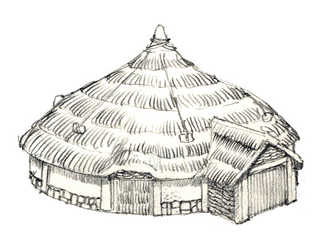
Most materials have been sourced within the woodland, including oak, hazel, ash and clay for the walls. We cut and bundled reeds for the thatch from the Strumpshaw Fen RSPB Nature reserve and consulted with Kent Archaeological Society.
First
Prev
End of slideshow
-
 Frith Wood - creating new ponds
Frith Wood - creating new ponds
The first new pond is now becoming established. read more...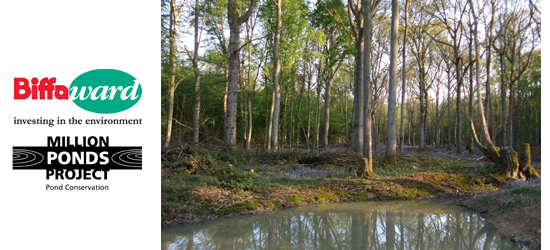
This is the first pond to be regenerated. It was dug out in March 2009 and is now becoming established, filling with water and wildlife. We are now funded by Biffaward, Million Ponds Project and have reinstated two further ponds.
Click here for press and more pond news
Press - click on pic for larger image
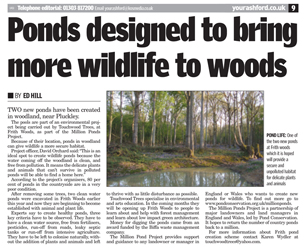
Prev
Next
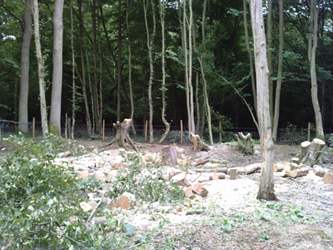
The ponds are adjacent to a medieval ditch and bank system within the woodland.
Once this is re-established the woodland will be further diversified, offering a wider variety of habitats. First the area has to be cleared.First
Prev
Next
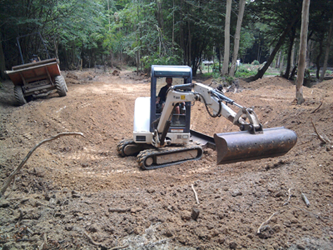
The next step is digging the pond.
First
Prev
Next
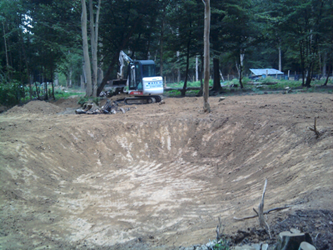
This shows the pond after the digging is complete, before it naturally starts to fill with water.
First
Prev
Next

Our third regenerated pond.
First
Prev
End of slideshow
-
 "Feast", The Thames Festival
"Feast", The Thames Festival
For the last 3 years Touchwood has been lead gardeners for Feast, read more...For the last 3 years Touchwood has been lead gardeners for Feast, growing food in allotments and schools and creating gardens in the community. This year saw Community container garden creation in public spaces around the River Thames with various groups: Housing Associations, the homeless, the elderly, community groups and schools.
The container gardens were then brought to Southwark Bridge for the Feast alongside the food and feasting tables.
Southwark Bridge was closed to traffic for the entire day and the bridge itself was transformed into a magical wonderland of eateries and produce. The children created a spectacular performance to open the bridge, reminiscent of traditional harvest offerings of food. Soup was cooked directly on the bridge, there were food ceremonies with locally grown produce from local growers and the children, and a spectacular harvest festival supper.
With an eclectic mix of food and drink, the Feast on the Bridge catered for all tastes and no doubt tempted many away from their normal fare. There was everything from simple pumpkins to amazing gypsy music, an array of delicious goodies to eat and a wealth of amazing sights to see.
A true reminder of our rural traditions and our relationship with the soil.Next
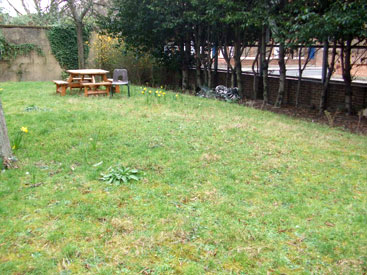
This is a picture of the Raey school garden before work commenced.
Prev
Next
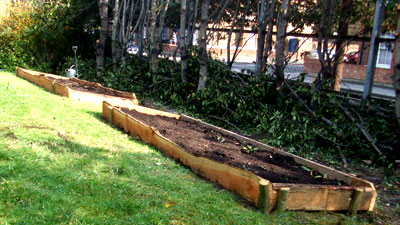
These are the raised beds we built from Larch wood and filled with good growing medium.
First
Prev
Next

The children tend the plants, from sowing the seeds through to harvest. They learn how to weed and feed the gardens and add nutrition to their diets.
First
Prev
Next
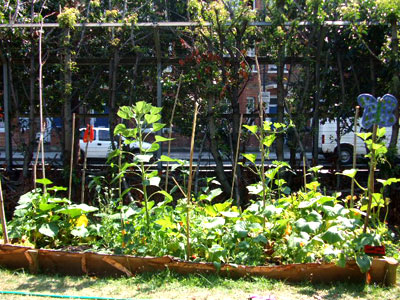
The food growing beds have filled up with food.
First
Prev
Next
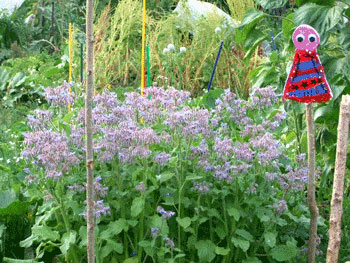
We also made insect 'scarecrows' to decorate the garden. The children harvested their vegetables wearing the costumes designed for their Feast performance.
First
Prev
Next
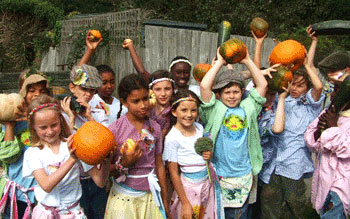
There was a pumpkin competition at the Feast on the Bridge with the Royal Horticultural Society and the Fortean Times.
First
Prev
Next
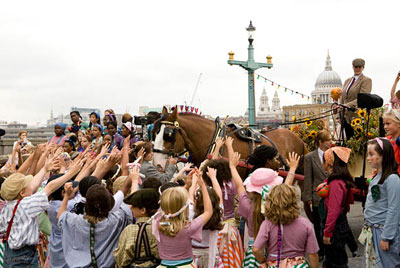
There was a huge performance with offerings of food and a global harvest song.
First
Prev
Next
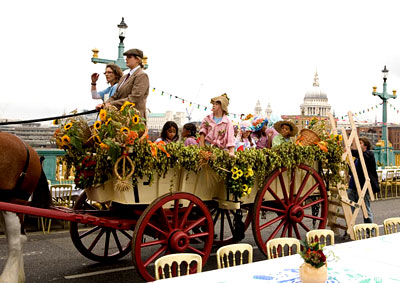
The cart arrived with all the produce of the harvest.
First
Prev
Next

Here are the feast tables.
First
Prev
Next
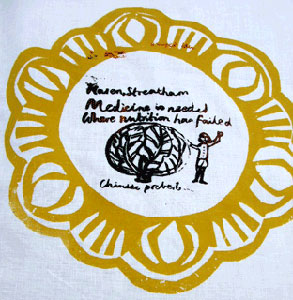
The table cloths were screen printed with 100s of Londoner's stories about food.
First
Prev
Next
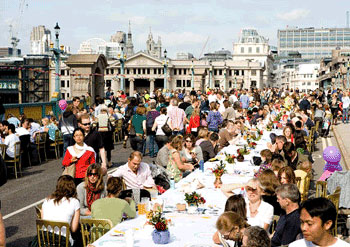
Here are people sitting down and starting to eat.
First
Prev
Next
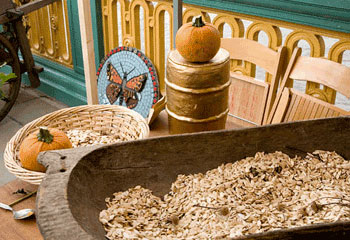
This is part of the Touchwood seed stall.
First
Prev
Next
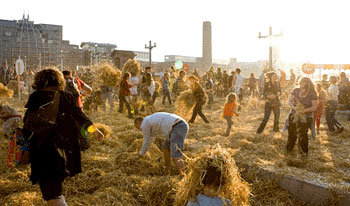
Heres where the biggest hay fight known to central London took place.
First
Prev
Next
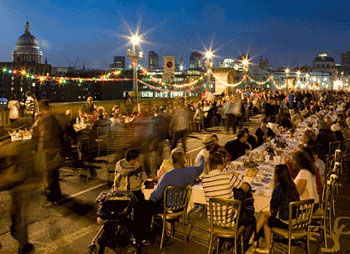
After dark.
First
Prev
End of slideshow
-
 Orleans House Gallery Sculpture
Orleans House Gallery Sculpture
Transformation was a piece of sculpture that was made with, read more...
Transformation was a piece of sculpture that was made with people from Spear Homeless Hostel, at Orleans House Gallery, Twickenham, London.
It was shown in the Views from the Street show at the gallery and is now permanently installed in the garden at the Spear Hostel, Richmond.
This is a mixed media sculpture made entirely of reclaimed materials A range of personal and famous poems and quotes were printed onto ceramic tiles, which spoke about the potential for society's and self transformation:
"A true revolutionary is guided by great feelings of love." Ernesto "Che" Guevara
'Everything you can imagine is real.' PicassoNext
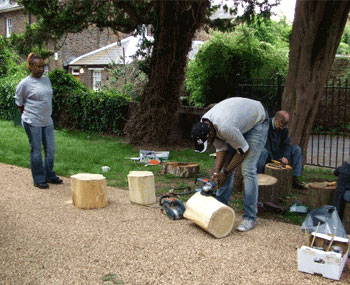
This shows people making the seating part of the sculpture, with reclaimed wood collected from the wood yard at Richmond Park.
Prev
Next
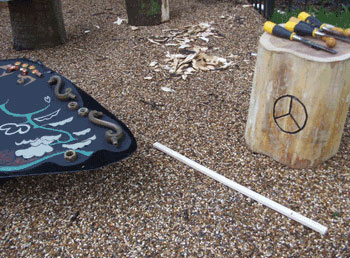
Here we can see the reclaimed aluminium being transformed into wings.
First
Prev
Next
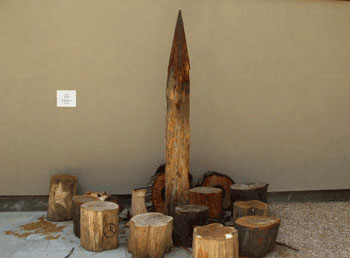
This shows construction of the piece using reclaimed sea defence wood: Green heart which is a tropical hardwood.
First
Prev
Next
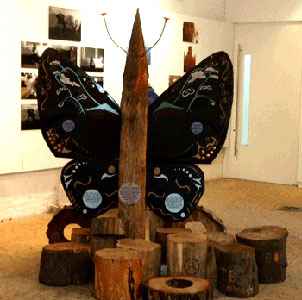
Here is the finished piece in Orleans House Gallery.
First
Prev
End of slideshow
-
 Meriden park, Birmingham
Meriden park, Birmingham
Touchwood has now completed the project at Meriden park, read more...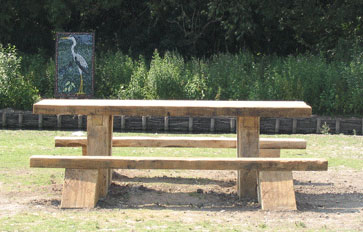
Touchwood has now completed the project at Meriden park in Birmingham. During the course of the project, we created a picnic area with a number of different artworks at the lakeside. These included and oversized oak table, a skateboard table, a series of 4-seasons logs with inlaid mosaic, a toddler table and thrones for the elderly with disabled access. -
 St Andrews School, Hove
St Andrews School, Hove
We are happy to announce that the St. Andrews School project, read more...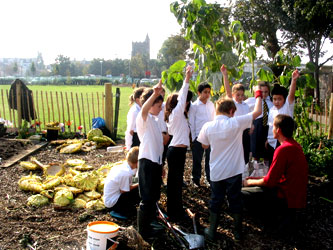
We are happy to announce that the St. Andrews School project in Hove, was successfully completed after 2 years work. Touchwood worked with St Andrews school in Hove following the rebuilding of the school on a new site. The brief was to create a stimulating environment with and for the children and staff, and to increase bio-diversity.
-
 International year of Soil - Artist Residency
International year of Soil - Artist Residency
Karen has been working as artist in residence at Hannah's for International Year of the Soil. read more... -
 Human Nature Bristol
Human Nature Bristol
Karen Francesca has also been chosen as one of the artists at the Human Nature event. read more... -
 Learning for a Sustainable Life
Learning for a Sustainable Life
Roundhouse construction process and woodland ecological report
read more... -
 Frith Wood - creating new ponds
Frith Wood - creating new ponds
The first new pond is now becoming established. read more... -
 "Feast", The Thames Festival
"Feast", The Thames Festival
For the last 3 years Touchwood has been lead gardeners for Feast, read more... -
 Orleans House Gallery Sculpture
Orleans House Gallery Sculpture
Transformation was a piece of sculpture that was made with, read more... -
 Meriden park, Birmingham
Meriden park, Birmingham
Touchwood has now completed the project at Meriden park, read more... -
 St Andrews School, Hove
St Andrews School, Hove
We are happy to announce that the St. Andrews School project, read more...











